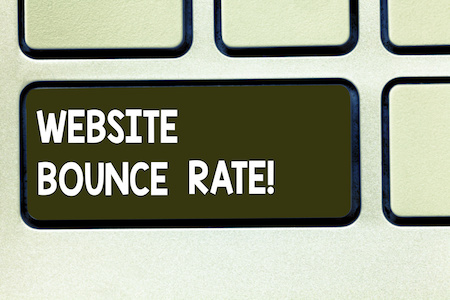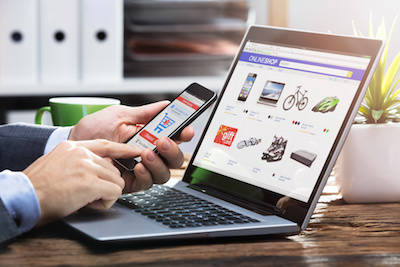When you have a website that depends on page views or conversions for income, don’t you think you would want to keep your visitors on your website for as long as possible? Improving conversions is the fastest way to turn your traffic into leads and sales.

The answer is yes, and you would want to prevent them from bouncing off to somewhere else on the web. There are some ways in which you can do that, but you have to understand why people leave in the first place as well as know the methods that keep them around long enough to convert into a customer.
Let’s explore strategies and learn how to lower your bounce rate and improve conversions to increase your bottom line.
What Is A Bounce Rate?
The first thing that you have to understand is the website bounce rate and SEO. A bounce rate is simply a number used to signify how many people leave your site and how quickly they do so. Many people use different metrics to measure the overall bounce rate, the most common being those used in a Google Analytics server.

A ‘bounce’ is someone coming to your site and leaving immediately without converting to a sale. If someone comes to your website and reads through your homepage or navigates to other pages on your site, this is not necessarily considered a bounce. A bounce happens in the first couple of seconds that someone is on your website. Even if you get a site visitor boost, you will not see success unless you have a lower bounce rate.
There are several reasons why a bounce might happen, and your digital marketing goal would be learning ways to reduce those people leaving. If you have lots of data to download before someone can access your site, and it takes over a half a second or so, you’re probably going to see a higher bounce rate. People don’t want to wait for websites to load anymore, either on computer or mobile device. If your blog post takes over a second to load or has a session timeout due to all of the ads and popups on your site, people will likely click the back button and move on to something else.
People also bounce because they cannot quickly find the information they came for or the product they came to buy. If your traffic source arrives at your landing page and has to navigate throughout the entire site to get to the information they came there for, you will see a big bounce rate. This is why the meta description can be essential, making sure you use keywords in the description that are also on your blog or website.
Also, if your website design is weak, and does not inspire someone’s trust, then they’re not going to want to use the information that they get from it, and they are not going to want to buy anything from your product page. This could be a reason why you have a live chat so they can chat with you right then and there to ask any questions if they do feel unsure about the product or need any assistance. You can see these numbers reflected in web analytics conversion numbers.
How To Decrease Bounce Rates & Increase Conversion
There are several ways that you can decrease the overall high bounce rate and increase conversions. A conversion rate is when a user visits your website and completes an action that you have set up as the end goal for your website visitors. A conversion could be purchasing an item from your site; it could be clicking a referral link to a third-party site, or it could be something as simple as providing an email address to join a mailing list. Let’s look at three methods that will help you reduce bounce and increase conversions.
Method 1: Improve Site Loading Speed

One of the best ways to improve your website’s bounce rate and SEO is to make sure that your site loads quickly. Quick loading not only keeps visitors on the site, but also improves your rankings in Google, and your Google Analytics bounce rate. Google checks to see what the load time is for many of their top-ranked websites, and if your website does not have quick site speed and takes longer to load than other websites that you are ranked with, then you may find yourself losing your place in the Google index or a different search engine like Bing.
Method 2: Place CTA Prominently
Some people are coming to your site to take action. People know exactly what they want already; they are just looking for a place to find what they want. That’s why it is crucial to place a call to action (CTA) button prominently so that anyone who has already done their product research and knows what they want will be able to fulfill their desire from your site. If it is a purchased product, you want them to be able to buy it from you as soon as they arrive on your page. Your target audience does not need comparisons or sales pitches. They’ve already made up their mind to buy. The only thing they need is a clear call to action and a gentle nudge in the right direction. You want to conduct test analytics through an analytics server to determine where the optimal placement is.

Test analytics through Google or another search engine analytics application can tell you where your CTA converts best. That way, when you get a visitor boost or increase site visitors, you will be able to take advantage of your low bounce rate.
Method 3: Optimize Your Site For The Right People
People will be coming to your site for specific reasons. Some people will be looking for information, some will have gotten there by accident, and others specifically ended up on that page because of something that they typed. You can influence what kind of people come to your site and their motivation, so it is essential to focus on user engagement. Social media can have a significant impact on this, so it is critical for your company marketers to market the product well, so it catches the audience’s attention.

For example, if you optimize your site around answering a question, then most of the traffic that comes to your website is going to be people that are looking to answer that question through a search result. But if you optimize your site around the buying keyword for a particular product, and people land on a page where they can buy that product, that’s when you are going to see conversion optimization and avoid high bounce rates. Make sure you target the right audience of people with your content marketing.
Other Tips To Improve Your Website
Other ways increase the number of people that take action on your site and minimize the amount that clicks the back button. First off, make sure that your text is easy to read and placed in such a way as to funnel the reader towards the call to action naturally. You don’t want big blocks of text that look intimidating; you don’t want to use lots of big words, and you want to maintain a friendly tone that draws the reader in from the first sentence and keeps them reading until the very end.
You also need to make sure that you are telling a story. Customers respond to stories, and when you improve your brand storytelling, you are improving the number of positive responses you get from your content. Finally, make sure nothing is standing in the way between your customer and the call to action. You don’t want popups or distracting sidebars or anything else that keeps them from taking action on that site. Popups ads or information can increase your site’s bounce rate and prevent content conversion, and if you are working hard to increase site visitors, you don’t want popups ads preventing you from having the best site possible. Include a plugin or two instead to help improve the content conversion.
Implementing the things described in this article will go a long way towards increasing content conversion and ensuring that as few people as possible bounce off your site and go somewhere else.





